|
|
|||
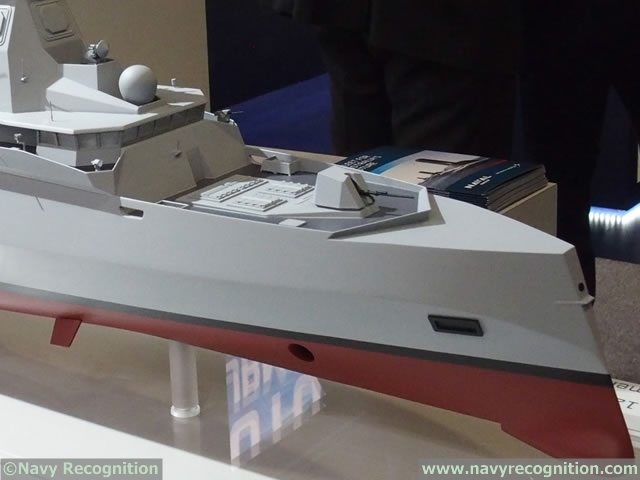 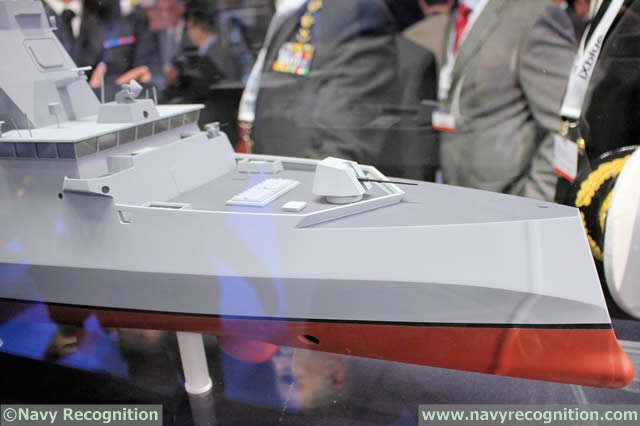 Detailed view of the FTI (export configuration) bridge area at Pacific 2017 (top) compared to the bridge area at Euronaval 2016 for the FTI design unveiling. Note that the "hull mounted sonar" has been moved as well and is now a "bow sonar". Detailed view of the FTI (export configuration) bridge area at Pacific 2017 (top) compared to the bridge area at Euronaval 2016 for the FTI design unveiling. Note that the "hull mounted sonar" has been moved as well and is now a "bow sonar". |
|||
|
|
|||
|
Improvements around the bridge are many:
- The bridge wings have evolved significantly. Limited to the forward area of the bridge on the 2016 design, they have been enlarged and run along the sides of the bridge area on the 2017 design. - The kind of storage area right in front of the bridge, present on the 2016 design, is gone, giving a much more polished look. - The bridge itself is not so flat anymore: The linear row of windows has been truncated on each side, giving it a less perpendicular aspect. Above the bridge, the integration of the integrated mast, fire control and satellite link antennas has been improved as well: The two Syracuse military SATCOM antennas which used to be on each side of the SEA FIRE mast have been moved forward (directly on top of the bridge) and aft, on top of the helicopter hangar. The fire control is now placed on a "stealthy" base. The area surrounding the base of the mast has been cleared up and is not smoother. Finally, the wall directly below the bridge is more slanted now (it used to be very vertical, almost at a 90° angle) and the hatch to access the forward deck has been modified as well. Talking to Navy Recognition, a Naval Group frigate expert explained that the goal for all these design modifications was to improve, first, the radar cross section (RCS) of the FTI, as well as its exterior looks: "Design is quite important too for some customers". We, at Navy Recognition, find the end result quite convincing: The FTI is now sleeker and sharper thanks to the latest design improvements. The bow now features a small spray rail (to deflect the bow wave downward and reduce spray). During recent tank tests, the model featured two of them. The bow also features some low observable anchor pockets (in a similar fashion to those aboard the LPD 17 San Antonio-class), again, improving the stealthiness of the ship. Last but not least, the "hull mounted sonar" has been moved forward and is now a "bow sonar" (confirming our early report on the Thales Kingklip Mk2 sonar) |
|||
|
|
|||
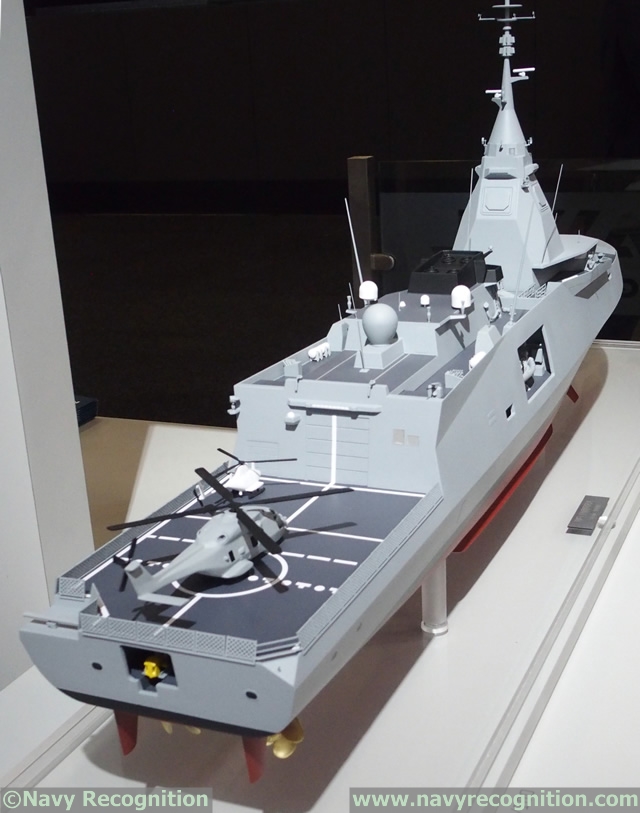 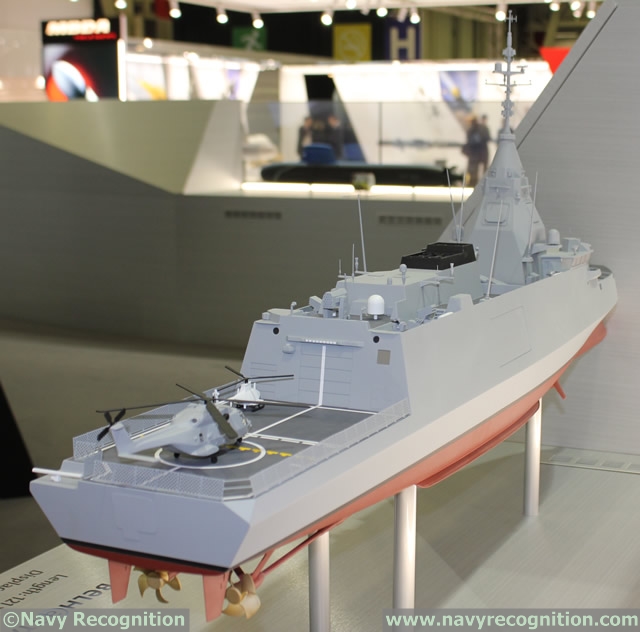 Detailed view of the FTI aft area at Pacific 2017 (top) compared to the aft area at Euronaval 2016 for the FTI design unveiling. Detailed view of the FTI aft area at Pacific 2017 (top) compared to the aft area at Euronaval 2016 for the FTI design unveiling. |
|||
|
|
|||
|
The aft of the frigate received some design improvements too:
The superstructure around the helicopter hangar has been redesigned extensively. While the Euronaval 2016 model sported a trapezoidal shape, the latest design features an "X" shape. This superstructure design is a first on a Naval Group (DCNS) ship but is somewhat similar to some of the existing MEKO Frigates (with the sides of the superstructure going inward). |
|||
|
|
|||
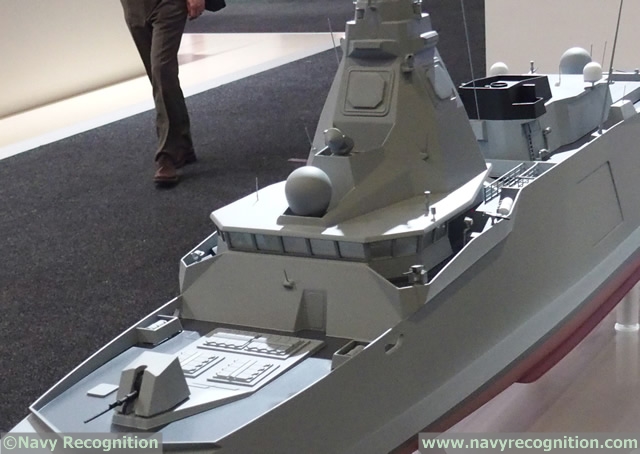 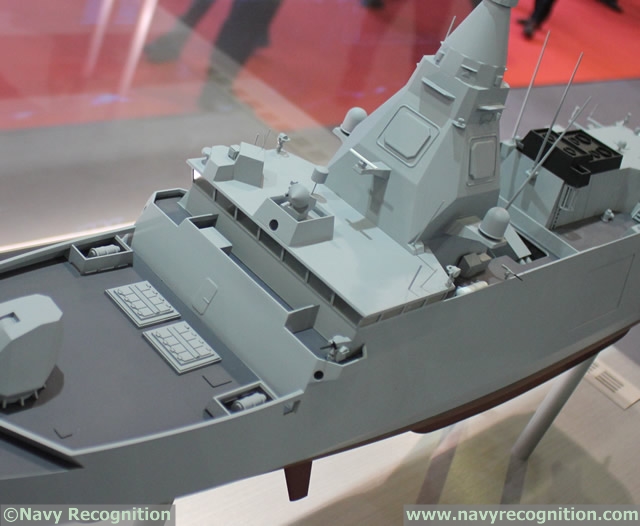 FTI (in export configuration, with 32x VLS) at Pacific 2017 (top) compared to the Belharra as unveiled by DCNS at Euronaval 2016. FTI (in export configuration, with 32x VLS) at Pacific 2017 (top) compared to the Belharra as unveiled by DCNS at Euronaval 2016. |
|||
|
|
|||
|
While this summer, the French Navy and procurement agency (DGA) were still comparing and testing FTIs in two configurations: Inverted bow design (à la DDG 1000 Zumwalt) and a more conventional bow design, it seems that the inverted bow design has finally been retained.
According to our information, the decoy launching system of the FTI will be the Sylena Mk2 by Lacroix: It appears that each FTI would be "fitted for" 4x launchers, but each ship would actually be "fitted with" 2x launchers. Depending on mission requirements and threats, a select number of frigate could deploy with the 4x launchers. It is our understanding that the French Navy already proceed in a similar way with the EW suites of the Lafayette class frigates: not all of them are fitted with jammers. Jammers are swapped between hull depending on operational schedule). This information may not be "set in stone" yet however. |
|||
|
|
|||
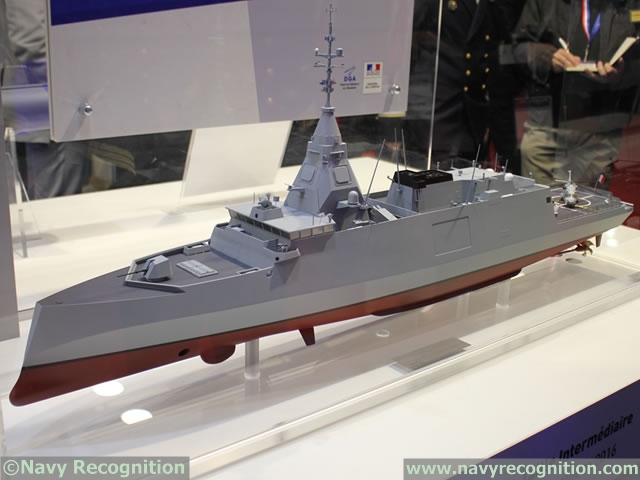 FTI scale model at Euronaval 2016 on the French MoD stand. FTI scale model at Euronaval 2016 on the French MoD stand. |
|||
|
|
|||
|
About the FTI
The French Defence Ministry announced the attribution to DCNS (now Naval Group) of a contract for the development and construction of five FTI (Frégate de Taille Intermédiaire or mid-size frigate) surface combatant intended for the French Navy in April this year. The first of the five frigates from this DGA-managed programme should be delivered in 2023 with an entry into active duty in 2025. The FTI will have a displacement of about 4200 tonnes with a crew of 125 sailors. It will be capable of anti-submarine warfare, anti-air warfare, anti-surface warfare as well as the support of special forces missions. The prime contractor is Naval Group while Thales is set to supply a number of brand new, next-gen systems: - The CAPTAS-4 Compact sonar - The SEA FIRE radar - Aquilon integrated naval communication system - The SENTINEL electronic warfare system Safran Electronics & Defense will supply a new electro-optical FCS, the PASEO XLR. Provisional configuration (to be confirmed): 76mm main gun 2x Narhwal 20mm remote guns 8x Exocet MM40 Blk III anti-ship missiles 2x Sylver A50 launchers for 16x Aster 30 missiles Space for 2x extra Sylver A70 launchers MU90 torpedoes Hangar for one NH90 helicopter and one UAV Fitted for 4x Sylena Mk2 decoy launchers but with 2x of them |
|||
Naval Group Refines Design of the FTI / Belharra Next Generation Frigate
- Posted On











